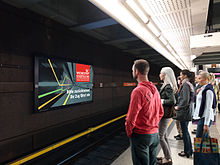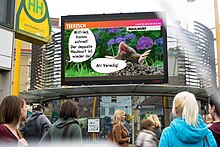Passenger television
The passenger Television is a medium that contains information about screens is on public transport or their stations.
In 1997, a technology developed by Bosch was used for the first time , which made safe television broadcasts possible in moving vehicles. The local trains from Saarbrücken to Frankfurt am Main were initially equipped with passenger TV, broadcast via DAB . At that time the program of the news channel n-tv was shown .
functionality
The idea behind this new medium is that information, news and entertainment are made available to the passenger as it were ( infotainment system ). For transport companies in particular, this is a modern, flexible medium for communicating with passengers (company information, self-promotion). Parts of the costs are refinanced through the insertion of advertising contributions. Right from the start, the TFT display technology, which was quite new at the time, was used to display the content . With their flat design, high resolution and corresponding brightness, these displays can be used in public transport vehicles. Right from the start, soundless systems were used to increase acceptance and avoid disruptions to passengers.
The editorial and advertising content as well as the company passenger information are often created in decentralized editorial offices. The data is then merged on a central server. The data is mostly distributed to the vehicles via DMB (bundled DAB) or WLAN . The computer in the vehicle saves the content, evaluates current time information and the position of the vehicle and thus determines which information (news, advertising, passenger information) is shown. The signals are then forwarded to the respective screens.
Germany
The first area-wide network was implemented in Hamburg in 1998 by the Infoscreen company in cooperation with Hamburger Hochbahn AG. Here, WLAN was used as the transmission technology. The first area-wide network with DMB supply (bundled DAB) was implemented at Expo 2000 in Hanover by üstra , X-CITY MARKETING Hannover GmbH and public broadcast Rundfunkgesellschaft mbH. The editorial content for Hamburg and Hanover is created by public broadcast Rundfunkgesellschaft mbH, which also supplies the stationary systems in the underground stations of Hanover and Stuttgart with content. The marketing of advertising time in Hanover is carried out by X-CITY MARKETING Hannover GmbH in Hamburg through Ströer Deutsche Städtische Medien GmbH. In November 2018, a system went into operation in the S-Bahn and U-Bahn that provides information on traffic reports from the other company.
In Germany, Berlin's subways are also equipped with systems across the board by the Berliner Fenster company . The subway vehicles in Munich have also been equipped with it since 2013 . The company is called Münchner Fenster there and contains a combination of passenger information and infotainment on two screens.
Trend Network AG (TNAG) from Potsdam operated passenger television for over 100 LVB trams and buses in Leipzig as well as in Düsseldorf, Bonn, Plauen, Gera and also in other European countries. In the meantime, however, Trend Network AG had to file for bankruptcy. In Leipzig, videowerkstatt.net has been the successor and new operator since August 2010. Here, among other things, local news from the local television broadcaster Leipzig TV, which is also operated by videowerkstatt.net, is prepared for passenger television .
The television in Dresden GmbH (Dresden television) supplies Dresden. The Vestische streetcars GmbH is managed and in terms of passenger television by the company Mental surgical supplies.
There are also a number of smaller locations that mostly rely on systems in buses and are marketed locally. One example is the systems in Osnabrück, where the Osnabrück newspaper is responsible for the content and marketing.
Austria

In Austria, the passenger television concept is largely implemented through Infoscreen and Digilight.
Digilight
Since 2010, various stations of the Austrian Federal Railways have had stationary systems for passenger television. Digilight Werbe- und Netzwerk GmbH is the provider.
Infoscreen
Infoscreen is a digital, soundless medium in and around public transport and was first put into operation in the spring of 1998 in Vienna's Stephansplatz subway station. Further stations followed and, from 2004, other federal states. In the winter of 2007/2008, the first mobile passenger TVs went into Dr. Richard in operation. The network is gradually being expanded. In 2013, the Austrian Patent Office issued Infoscreen the traffic validity certificate .
Infoscreen is shown in the media analysis (Austria) as a separate media category and, as of March 2017, achieved a weekly reach of 1.5 million people as an advertising medium.
The content of Infoscreen includes international, national and regional news, culture, sport, weather, entertainment and event tips from national and international content partners such as Reuters , Kurier (daily newspaper) , Tiroler Tageszeitung , Wiener Zeitung , NEWS publishing group , Laola1.at , Life Radio etc. Around 70 percent of the content is editorial, the rest advertising.
The Infoscreen program has a duration of 14 minutes and a data volume of approx. 1.5 GB and is transmitted via HSDPA to the playback systems in the underground stations as well as to the buses and trams.
Individual evidence
- ↑ Secure video transmission to mobile participants. In: deutscher-zukunftspreis.de. Retrieved November 18, 2018 .
- ^ Markus Lorenz: New passenger television for Hamburg's underground and suburban trains. In: shz.de. November 2, 2018, accessed November 16, 2018 .
- ↑ Passenger television - MVG and Münchner Fenster are on the air. Retrieved November 15, 2018 .
- ↑ Infoscreen maintains flight altitude in the media analysis. (PDF; 304 KB) In: infoscreen.at. March 2017. Retrieved August 17, 2017 .


